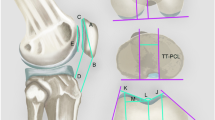Abstract
Background
Results of treatment for acute knee dislocations and multiligament knee injuries may be influenced by a multitude of patient- and injury-related factors, including neurologic function, vascular status, ipsilateral fractures, and joint stability. The development of heterotopic ossification (HO) may nullify any benefits of reconstruction, because it can cause stiffness and discomfort. Identifying factors associated with HO after knee dislocation may help identify patients who might benefit from prophylaxis.
Questions/purposes
The purposes of this study were (1) to identify specific risk factors for the development of HO in patients with knee dislocation; and (2) to elucidate the relationship between the presence of absence of HO and postoperative range of motion.
Methods
Between 2005 and 2010, we performed 101 multiligament reconstructions for patients with knee dislocations, of which 91 (90%) in 91 patients were available for followup at a minimum of 6 months (mean, 18 months; range, 6–44 months), and were reviewed here. AP and lateral radiographs were reviewed for all patients and HO was classified according to the Mills and Tejwani classification system. This knee dislocation cohort was separated into two groups based on the presence or absence of HO for comparison. Using a significance level of p < 0.05 for factors in the univariate analyses, we identified potential variables for a multivariate logistic regression model to identify risk factors predicting development of HO in patients with multiligament knee injuries; multivariate analysis then was performed to mitigate the influence of potentially confounding variables. Thirty patients (34%) developed HO after multiligament knee injury in our series.
Results
Posterior cruciate ligament reconstruction was the only independent predictor of HO that we identified (odds ratio, 6.3; 95% confidence interval, 1.2–34.6). Patients who developed HO were more likely to develop stiff knees and undergo surgery (50%; 15 of 30 patients) versus those without HO (12%; seven of 58 patients) to attempt to restore functional range of motion (p < 0.001).
Conclusions
HO is a common complication after knee dislocation and can diminish range of motion and cause patients to undergo further surgery. Posterior cruciate ligament reconstruction is an independent risk factor for the development of HO. Strategies to identify risk factors for, and safe prevention of, HO after multiple ligament injury and surgery should be investigated going forward.
Level of Evidence
Level III, therapeutic study. See Guidelines for Authors for a complete description of levels of evidence.

Similar content being viewed by others
References
Chen HC, Yang JY, Chuang SS, Huang CY, Yang SY. Heterotopic ossification in burns: our experience and literature reviews. Burns. 2009;35:857–862.
Cipriano CA, Pill SG, Keenan MA. Heterotopic ossification following traumatic brain injury and spinal cord injury. J Am Acad Orthop Surg. 2009;17:689–697.
Citak M, Suero EM, Backhaus M, Aach M, Godry H, Meindl R, Schildhauer TA. Risk factors for heterotopic ossification in patients with spinal cord injury: a case-control study of 264 patients. Spine (Phila Pa 1976). 2012;37:1953–1957.
Kaplan FS, Hahn GV, Zasloff MA. Heterotopic ossification: two rare forms and what they can teach us. J Am Acad Orthop Surg. 1994;2:288–296.
Mills WJ, Tejwani N. Heterotopic ossification after knee dislocation: the predictive value of the injury severity score. J Orthop Trauma. 2003;17:338–345.
Nauth A, Giles E, Potter BK, Nesti LJ, O’Brien F P, Bosse MJ, Anglen JO, Mehta S, Ahn J, Miclau T, Schemitsch EH. Heterotopic ossification in orthopaedic trauma. J Orthop Trauma. 2012;26:684–688.
Pape HC, Zelle BA, Lohse R, Stalp M, Hildebrand F, Krettek C, Panzica M, Duhme V, Sittaro NA. Evaluation and outcome of patients after polytrauma: can patients be recruited for long-term follow-up? Injury. 2006;37:1197–1203.
Patton WC, Tew WM. Periarticular heterotopic ossification after multiple knee ligament reconstructions. A report of three cases. Am J Sports Med. 2000;28:398–401.
Potter BK, Forsberg JA, Davis TA, Evans KN, Hawksworth JS, Tadaki D, Brown TS, Crane NJ, Burns TC, O’Brien FP, Elster EA. Heterotopic ossification following combat-related trauma. J Bone Joint Surg Am. 2010;92(Suppl 2):74–89.
Schenck R. Classification of knee dislocations. Oper Tech Sports Med. 2003;11:193–198.
Shafritz AB, Shore EM, Gannon FH, Zasloff MA, Taub R, Muenke M, Kaplan FS. Overexpression of an osteogenic morphogen in fibrodysplasia ossificans progressiva. N Engl J Med. 1996;335:555–561.
Stannard JP, Sheils TM, Lopez-Ben RR, McGwin G Jr, Robinson JT, Volgas DA. Vascular injuries in knee dislocations: the role of physical examination in determining the need for arteriography. J Bone Joint Surg Am. 2004;86:910–915.
Stannard JP, Wilson TC, Sheils TM, McGwin G Jr, Volgas DA, Alonso JE. Heterotopic ossification associated with knee dislocation. Arthroscopy. 2002;18:835–839.
Author information
Authors and Affiliations
Corresponding author
Additional information
Each author certifies that he or she, or a member of his or her immediate family, has no funding or commercial associations (eg, consultancies, stock ownership, equity interest, patent/licensing arrangements, etc) that might pose a conflict of interest in connection with the submitted article.
All ICMJE Conflict of Interest Forms for authors and Clinical Orthopaedics and Related Research ® editors and board members are on file with the publication and can be viewed on request.
Each author certifies that his or her institution approved the human protocol for this investigation, that all investigations were conducted in conformity with ethical principles of research, and that informed consent for participation in the study was obtained.
About this article
Cite this article
Whelan, D.B., Dold, A.P., Trajkovski, T. et al. Risk Factors for the Development of Heterotopic Ossification After Knee Dislocation. Clin Orthop Relat Res 472, 2698–2704 (2014). https://doi.org/10.1007/s11999-014-3730-7
Published:
Issue Date:
DOI: https://doi.org/10.1007/s11999-014-3730-7




